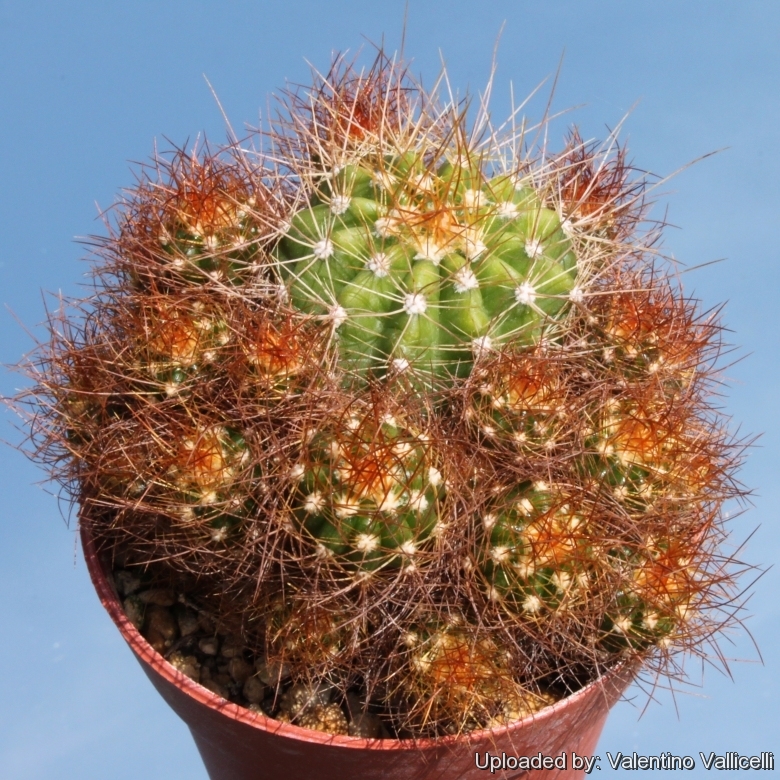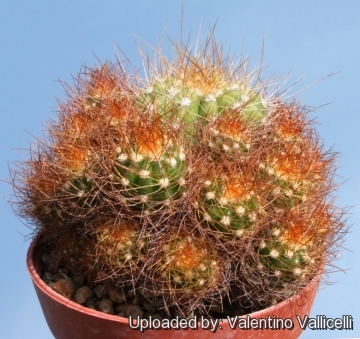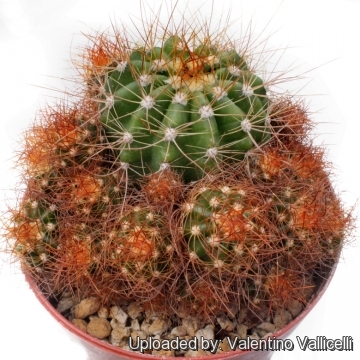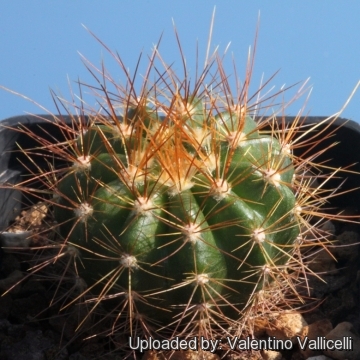= Coleocephalocereus purpureus f. caespitosus
Accepted Scientific Name: Coleocephalocereus purpureus (Buining & Bredero) F.Ritter
Kakteen Südamerika 1: 128. 1979

Buiningia purpurea f. caespitosa (Coleocephalocereus purpureus f. caespitosus) Photo by: Valentino Vallicelli
Origin and Habitat: Garden origin
Synonyms:
See all synonyms of Coleocephalocereus purpureus
back
Accepted name in llifle Database:Coleocephalocereus purpureus (Buining & Bredero) F.RitterKakteen Südamerika 1: 128. 1979Synonymy: 4
back
Description: Coleocephalocereus purpureusSN|6341]]SN|6341]] f. caespitosus an odd clustering plant that forms lots of axillary shoots from the areoles at the base of the stem, while the typical Coleocephalocereus purpureusSN|6341]]SN|6341]] (= Buiningia purpureaSN|6342]]SN|6342]]) is a solitary or few branched plant.
Growth habits: It is a mutant form that clusters like a mad just at an early age, readily forming crowded mounds or cushions with dozen of small heads.
Stem. Deep green often smaller than the type.
Areoles: Grey woolly.
Cephalia: Growing laterally near the stem's tip, with grey wool and golden yellow to brown bristles, but seldom the stems of Coleocephalocereus purpureusSN|6341]]SN|6341]] f. Caespitosus are big and powerful enough for starting to flower.
Spines: Golden yellow to red, later grey.
Central spines: 4, one as long as 7 cm , others 3-3.5 cm
long.
Radial spines 12, spreading, needle-like, somewhat curved, 12-25 mm long.
Blooming Habits: Purplish red, nocturnal, tubular, very melocactus-like flowers, up to 30 mm long and 12 mm in diameter.
Fruits: Globose to oval, shiny red, 17—25 mm long, to 17 mm in diameter.
Subspecies, varieties, forms and cultivars of plants belonging to the Coleocephalocereus purpureus group
Notes: Lateral cephalia occurs in several species of cacti like Espostoa, Pseudoespostoa, Thrixanthocereus, Vatricania (now all considered to be Espostoa), Buiningia, Facheiroa, Micranthocereus and others. These plants are all columnar and grow as ribbed green juvenile columns with an ordinary sparse spine cover. Once old enough, they begin making a cephalium, but only along one side.
Bibliography: Major references and further lectures
1) Edward Anderson “The Cactus family” Timber Press, Incorporated, 2001
2) James Cullen, Sabina G. Knees, H. Suzanne Cubey "The European Garden Flora Flowering Plants: A Manual for the Identification of Plants Cultivated in Europe, Both Out-of-Doors and Under Glass" Cambridge University Press, 11/Aug/2011
3) David R Hunt; Nigel P Taylor; Graham Charles; International Cactaceae Systematics Group. "The New Cactus Lexicon" dh books, 2006
4) Urs Eggli, Leonard E. Newton: “Etymological Dictionary of Succulent Plant Names” Springer, Berlin/Heidelberg 2010
9) Taylor, N.P., Machado, M. & Braun, P. 2013. Coleocephalocereus purpureus. In: IUCN 2013. "IUCN Red List of Threatened Species." Version 2013.2. <www.iucnredlist.org>. Downloaded on 06 December 2013.
10) Kakteen und andere Sukkulenten . Volume 24, number 6, pag. 121–123 1973
11) Friedrich Ritter "Kakteen in Südamerika: Ergebnisse meiner 20jährigen Feldforschungen" Selbstverlag, 1979
 Buiningia purpurea f. caespitosa (Coleocephalocereus purpureus f. caespitosus) Photo by: Valentino Vallicelli
Buiningia purpurea f. caespitosa (Coleocephalocereus purpureus f. caespitosus) Photo by: Valentino Vallicelli Buiningia purpurea f. caespitosa (Coleocephalocereus purpureus f. caespitosus) Photo by: Valentino Vallicelli
Buiningia purpurea f. caespitosa (Coleocephalocereus purpureus f. caespitosus) Photo by: Valentino Vallicelli Buiningia purpurea f. caespitosa (Coleocephalocereus purpureus f. caespitosus) Photo by: Valentino Vallicelli
Buiningia purpurea f. caespitosa (Coleocephalocereus purpureus f. caespitosus) Photo by: Valentino VallicelliSend a photo of this plant.The gallery now contains thousands of pictures, however it is possible to do even more. We are, of course, seeking photos of species not yet shown in the gallery but not only that, we are also looking for better pictures than those already present.
Read More... Cultivation and Propagation: These tropical cacti are not the easiest things to grow and aren’t plants for beginners.
Growth rate: It is a relatively rapidly growing given the best conditions.
Soils: It likes very porous standard cactus mix soil.
Repotting: The root system is weak and generally resents being repotted and can take a long time to re-establish. Use pot with good drainage.
Light: They prefer very bright light, not as much as the most arid growing cacti, but plenty nonetheless. Tends to bronze in strong light, which encourages flowering and heavy spine production.
Watering: They grow from April to October and cannot endure long stretches of total dryness, and also too much water will rot them, as their weak root systems tends to be inefficient at sucking up water from wet soil. Nonetheless, again as a result of their tropical origins, they need a fair amount of water, but allow the soil to dry quite a bit before watering again.
Fertilization: Do not feed in winter.
Hardiness: They rest from October to April but can’t stand cold, or even fairly cool temperatures, so is indispensable to keep them above 8-12°C at all times, severe damage or death occurring at temperatures that the great majority of cacti wouldn’t mind in the least and prefer more frequent water in winter than other cacti, say once a month. (but hardy to 4 C ° C for short periods). However warmth throughout the year will increase the grower's success (minimum 12° to 20° C during rest season).
Pests & diseases: It may be attractive to a variety of insects, but plants in good condition should be nearly pest-free, particularly if they are grown in a mineral potting-mix, with good exposure and ventilation. Nonetheless, there are several pests to watch for:
- Red spiders: Red spiders may be effectively rubbed up by misting the vulnerable plants every day
- Mealy bugs: Mealy bugs occasionally they develop aerial into the new growth among the wool with disfiguring results, but the worst types develop underground on the roots and are invisible except by their effects.
- Scales: Scales are rarely a problem.
- Rot: it is only a minor problem with cacti if the plants are watered and “aired” correctly. If they are not, fungicides won't help all that much.
Propagation: Exclusively by Seeds. Sow in February-march in a light, sandy, porous soil. Cover germinating tray with glass to prevent seed from drying out. Germination is most successful at a temperature of 18 to 22° C.













